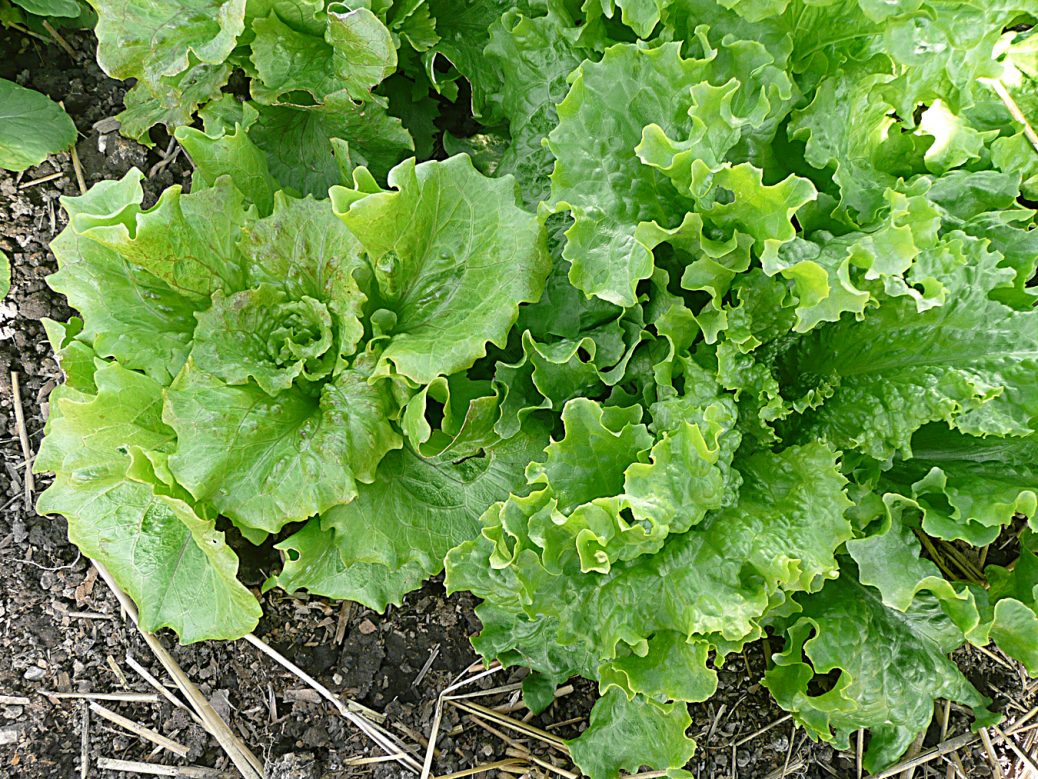By Sylvia Gist
I like my salads to be colorful and tasty, which means I need a variety of “greens.” I like dark and light green leaves, red leaves, and different leaf shapes and textures in my salads.
To get the ones I like, I grow them myself. One of the big advantages is that most grow quite fast so I don’t have to wait months to get a crop. Most also can be harvested over a period of time. Many are cold hardy so you can grow them throughout most of three seasons, depending upon where you live. Grab a seed catalog that caters to your climate and peruse the appropriate sections to find what appeals to you.
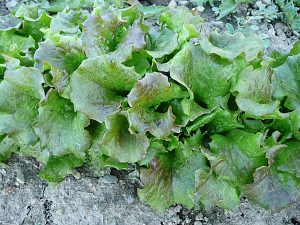 Red-tinged winter lettuce planted in August
Red-tinged winter lettuce planted in August
Lettuce
Lettuce is probably the mainstay of any salad. There are seemingly unlimited varieties and I keep discovering new favorites. There are romaine varieties to give you a heavier robust leaf, butterheads to provide soft creamy leaves, bibb varieties for a bit more crunch in a loosely-formed head, loose-leaf lettuces for big bunches of leaves in a wild assortment of shapes, and the iceberg types found in the grocery store (also called crisphead). Another category some companies use is Batavian, which is closer to a crisphead, but looser. Different seed companies seem to have different categories and also put the same variety in different categories. The best thing to do is read the description carefully and refer to the photos which most catalogs include.
Planting lettuce can be tricky. It must be planted shallowly at no more than ¼-inch deep. Keep it moist, but too much water can make the seed wash into another spot or get buried under too much dirt. This happens in a hard rain. Too much water can also encourage damping off.
Another plan is to start it indoors in flats and transplant it out when it has a few leaves, making sure to harden off or acclimate the plants first. I like to do this with the types I want to grow into nice heads; I can space the plants appropriately.
I plant lettuce mixes directly in the garden, and closer together, because I will be picking individual leaves from the time the plants are 4 inches high till they are no longer tasty or go to seed. A lettuce mix can give you a continuous supply for several weeks. The mixes usually contain all types, but when planted closely in a row and harvested at baby leaf, they do not form heads. The upside is that the romaines included will give you more body than some of the loose-leaf ones that are so fragile. One of my favorite mixes comes from High Mowing Organic Seeds in Vermont.
Lettuce needs water. Hot, dry weather can make it bitter. Some varieties are better than others at resisting this tendency. A variety that is noted for resisting bitterness is Anuenue (pronounced “uh-newy-newy”) which is a Hawaiian heirloom, categorized by some as a Batavian. Crowded, it becomes a twisted mess, but given room, it forms loose green heads and it is quite lovely and delicious.
When selecting varieties, consider your climate, when you want to plant, and what the catalog (or website) gives as a description. Some companies, such as Johnny’s Selected Seeds, are even recommending specific varieties for spring, summer, and fall. They are in Maine, so their advice is for northern gardeners. If you live in a warmer climate, you would either have to find a seed company farther south (like Southern Exposure Seed Exchange in Virginia) or make adjustments for temperature and other climate data. Seeds of Change in New Mexico notes which varieties are heat-tolerant, while Johnny’s will especially note cold-tolerant varieties.
I start planting in an unheated greenhouse in February here in the northern Rockies. Sometimes the seeds come up quickly if there is sunny weather but can lie there for weeks in cold overcast conditions. Luckily, unlike cucumber seeds, lettuce seeds won’t rot in the spring.
If you have no cold frame or other season-jumping equipment, most lettuce can be planted as soon as the soil can be worked. It may not germinate right away and when it does, it may grow slowly. In general, lettuce likes moderate weather to germinate, but grows faster in warmer weather. This planting (and successive ones before the temps really heat up) will last into warmer weather. In most places it helps to plant heat-tolerant ones if you want to be harvesting in July and August.
Some of my favorite varieties are Waldmann’s (a green curly leaf lettuce), Sierra (a really pretty crunchy bibb), Yugoslavian Red (a multi-colored butterhead), Olga (green romaine), Outredgeous (red romaine), May Queen (a butterhead), and Oscarde (red oak leaf). And I cannot forget Black Seeded Simpson, the only lettuce I knew as a kid; it makes an excellent wilted lettuce salad.
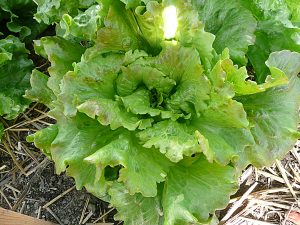
This Sierra lettuce will lend a nice crunch to the salad.
For summer lettuce, I plant in June when it is cool here, or July. Most of the June plantings will germinate fine, but for hotter weather I either start some heat tolerant varieties inside or use shadecloth to keep them cooler. Keeping the shadecloth too close to the plants seems to encourage green worms to feast, so I have to raise the covering high enough the birds can take care of the worms (or spray Bt).
For the fall, I start plants in August. Their growth will slow as the fall wears on and the weather cools. Most of these go into the greenhouse, but in the garden, rows could be covered with row cover for a bit more warmth or low tunnels for even more. If the varieties you choose are cold tolerant, they will actually recover from being slightly frozen. For this season I choose Tango (a really frilly leafed lettuce), Waldmann’s again, and Winter Density (a nice open romaine).
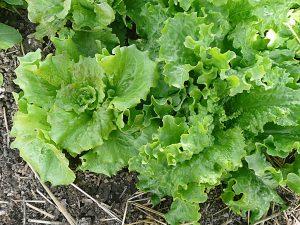
Sierra and Waldmann’s plants barely spaced far enough apart.
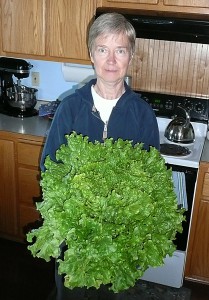
This Waldmann’s plant made a lot of salad, but also provided leaves to put on sandwiches.
Other greens
Mustards and Asian greens can add a different dimension to your salad. There are mild ones and hot ones. Some advantages of mustards are that they germinate quickly and grow fast — sometimes too fast. For salads, they are best at baby leaf size; if not picked they can get too big too fast. Some of my favorites are Mizuna (a mild cut leaf type), a colorful Red Giant, and Purple Streaked Mizuna (a spicy lacy leaf purple).
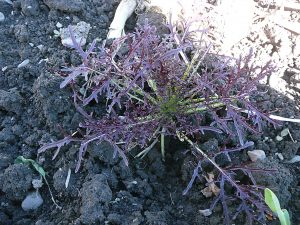
A Purple Streaked Mizuna plant self-seeded from last year’s plants gone to seed.
A couple of Asian greens that work easily in salads in the baby stage are tatsoi and Tokyo Bekana. Both grow quickly and have crunchy stems and a mild taste. There are many other greens in this category to try.
Spicy greens would have to include arugula and wrinkled crinkled cress (not watercress). Arugula grows really fast and takes on its characteristic spiciness quickly. Wrinkled cress takes a bit longer to form its frilly leaves (resembling curly parsley) which are more peppery than bitter, a totally different taste than arugula.
Mache, or corn salad, is yet another green addition to your salad. It likes cool/cold weather, easily making it through the winter here. I have some trouble with germination, though, and it goes to seed with warm weather.
Weeds can also be part of the salad. Purslane is rampant in my garden, and while my grandson likes to snack on it right after picking, I prefer to add it to the salad. A couple varieties are available from Johnny’s and other places if you don’t already have too much of it. Purslane, though, is not frost tolerant. Yet another weed to add to salads is Lamb’s Quarters, which can also be cooked.
Spinach can be a salad in itself or added to the mix. Most spinach loves cold weather and can be planted quite early. It will germinate before lettuce in the open garden. One of my favorites is Baby Elephant with large, wide, thickish, tender leaves. It is an open-pollinated variety I got from Irish Eyes Garden Seeds in Washington state. Space, a hybrid, is said to be ideal for winter growing. An early planting of spinach can reward you with greens before most anything else.
Beet tops are another pretty addition to the salad. Bull’s Blood beets are the red leaves in commercial salad mixes at the grocery store. You either pick the whole thing or take a few leaves and let the plant make some more. And if you quit picking leaves and the plant makes beets, they are good to eat as well.
Kale is another tasty green. Both the Red Russian and the White Russian varieties make very nice baby greens. They don’t seem to pick up their characteristic bitterness till they are larger. Planted in late summer, they are really tasty after a frost. Other kales, like Tuscan (also called black or dinosaur), can also provide interesting baby leaves.
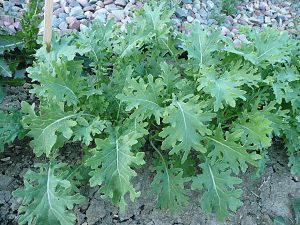
White Russian kale makes a nice addition to a green salad.
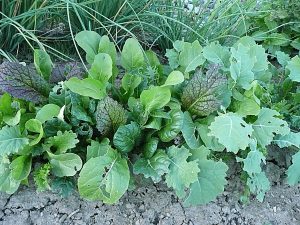
Fall greens include mustards, kale, arugula, tatsoi, and cress.
Swiss chard, at the baby stage, can be included in a salad. I particularly like the colorful ones like Rainbow, Bright Lights, or Rhubarb. With this plant you can harvest the baby leaves first, then let it grow harvesting larger leaves throughout the summer, and then cut it back and get baby leaves later. In some areas it will withstand a winter, but will then go to seed in that second year. Some varieties are hardier than others.
Pea shoots are a newcomer to the salad scene. Johnny’s lists a variety called Dwarf Grey Sugar Pea which can be used to grow shoots in less than 2 weeks. I haven’t tried this yet, but am including it for those who love the taste of peas.
Radishes and turnips are a couple of salad additions that grow fairly fast even though they aren’t greens. There are quite a lot of radish varieties that grow well in spring or fall — basically cooler weather. The turnips that go well in salads are called salad turnips: Hakurei, a hybrid white turnip with hairless tops, and Oasis, also a hybrid from Japan. Harvested at the 1.5 inch diameter size, they look a lot like a radish. Unfortunately both radishes and turnips are the prey of root maggots, so precautions must be taken. Row covers are one possibility.
Growing lettuce and greens
Soil and fertilizer: Lettuce and greens are a lush crop requiring a goodly amount of nitrogen, so it pays to plant them in good soil. I add compost to my soil, as well as alfalfa pellets, and sometimes use liquid fish fertilizer. I have had skunks pull up seedlings that were watered with fish fertilizer, so I am careful with it.
Container growing of greens can be both rewarding and a challenge. A friend of mine planted greens in planters and carried them in her camper and set them out at her campsite. Others have only a deck on which to grow a garden. A well-planted pot can supply salads for weeks.
Growing in containers can be challenging also, but it helps to follow some guidelines:
Greens need some sun to grow; the sun is what makes the red lettuces red. Put them under a cover and they are not.
Water is important. They need to be moist, but not soggy. Sometimes, depending on your climate, this may mean watering twice a day.
Greens also require heat, but not too much. If the container is metal or a dark color, it may heat up in the sun and cook the roots. A good temperature for the soil is 60 degrees.
Excellent soil is most helpful. Garden soil will compact. It is best to buy potting soil. Using the same soil every year won’t work unless you keep adding compost and nutrients.
Mix fertilizer with the potting soil so that it is distributed throughout. Then fertilize the plants on a regular basis. Most fertilizers will suggest a schedule for your container plants.
Drainage is a must. If the pot does not drain, a good rain could waterlog your plants. Drainage holes should be put in the bottom if there are none already.
The bigger the container, the better. It retains moisture and a level temperature best. A friend of mine used a large octagonal heavy duty plastic stock tank which worked very well. One website suggests nothing less than 18 inches across. Shallow containers can cause problems also. Larger containers will be difficult to impossible to move, though.
The container material can be important. Clay can absorb water which robs the plant. Dark containers and metal ones can get hot. Wood and plastic work well.
Pests such as slugs and green worms in lettuce and flea beetles in the mustard greens must be guarded against. If you use row covers, they must be tight to keep the pests out. Slugs, however, can get under them. Sprinkling crushed egg shells around the seedlings can help. Pillbugs have caused me problems, since they crawl through the dirt and like to eat tender seedlings. Diatomaceous earth can slow them down. However, I lost a whole planting of lettuce mix as they ate each plant as it poked its head up. I resorted to starting the seeds in the house and planting them out when they were bigger and sprinkling diatomaceous earth around the plant. Grasshoppers could eat your lettuce too. Catch them in the early morning if it is cool; chickens will eat them gladly — if you have chickens.
Planning is important also, but be flexible. While you will find a number of lettuce varieties and other greens available in seed packets at farm stores, hardware stores, greenhouses/nurseries, and even Walmart, I go for the much wider variety offered by seed catalogs, most of which also provide valuable growing instruction.
If you only have a small space, check out a lettuce mix or possibly mesclun which will have additional greens. Most will list what is in the mix. If you have a lot of space but not many to feed, consider staggering your plantings to get continuous harvests.
Allow for variation in germination, mostly due to unpredictable weather. In general, mustards tend to germinate quicker than lettuce and grow faster. Experiment. Find what works best in your area. I have tried some lettuce varieties that just did not work out well here; when one does well, I tend to stick with it. But I am always trying new ones and finding new favorites.
Seed saving is possible with lettuce. Just let them bloom and gather the seed when the white fuzzy fluff attached to the seed gets tired and old looking. It takes all summer for this to happen, so spring-planted lettuce works best. Also plants of different varieties should not be close to each other or just save one variety per year. Lettuce seed can be a little touchy so it isn’t one of those that will last forever.
Mustards will go to seed rather quickly; it is best to save seed from only one variety per year as some can cross-pollinate. Kale and chard produce seed in the second year, so they must be overwintered.
I hope you have a wonderful time growing your own salad greens, whatever colors you choose. I do have one warning though: Some lettuce plants are so beautiful at maturity that I am reluctant to harvest them. Take a photo if necessary, but eat them. You won’t be sorry!

